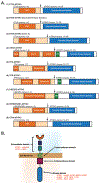Revisiting NTRKs as an emerging oncogene in hematological malignancies
- PMID: 31551508
- PMCID: PMC7410820
- DOI: 10.1038/s41375-019-0576-8
Revisiting NTRKs as an emerging oncogene in hematological malignancies
Abstract
NTRK fusions are dominant oncogenic drivers found in rare solid tumors. These fusions have also been identified in more common cancers, such as lung and colorectal carcinomas, albeit at low frequencies. Patients harboring these fusions demonstrate significant clinical response to inhibitors such as entrectinib and larotrectinib. Although current trials have focused entirely on solid tumors, there is evidence supporting the use of these drugs for patients with leukemia. To assess the broader applicability for Trk inhibitors in hematological malignancies, this review describes the current state of knowledge about alterations in the NTRK family in these disorders. We present these findings in relation to the discovery and therapeutic targeting of BCR-ABL1 in chronic myeloid leukemia. The advent of deep sequencing technologies has shown that NTRK fusions and somatic mutations are present in a variety of hematologic malignancies. Efficacy of Trk inhibitors has been demonstrated in NTRK-fusion positive human leukemia cell lines and patient-derived xenograft studies, highlighting the potential clinical utility of these inhibitors for a subset of leukemia patients.
Figures


References
-
- Rowley JD. Letter: a new consistent chromosomal abnormality in chronic myelogenous leukaemia identified by quinacrine fluorescence and Giemsa staining. Nature. 1973;243:290–3. - PubMed
-
- de Klein A, van Kessel AG, Grosveld G, Bartram CR, Hagemeijer A, Bootsma D, et al. A cellular oncogene is translocated to the Philadelphia chromosome in chronic myelocytic leukaemia. Nature. 1982;300:765–7. - PubMed
-
- Daley GQ, Van Etten RA, Baltimore D. Induction of chronic myelogenous leukemia in mice by the P210bcr/abl gene of the Philadelphia chromosome. Science. 1990;247:824–30. - PubMed
-
- Heisterkamp N, Jenster G, ten Hoeve J, Zovich D, Pattengale PK, Groffen J. Acute leukaemia in bcr/abl transgenic mice. Nature. 1990;344:251–3. - PubMed
-
- Druker BJ, Sawyers CL, Kantaijian H, Resta DJ, Reese SF, Ford JM, et al. Activity of a specific inhibitor of the BCR-ABL tyrosine kinase in the blast crisis of chronic myeloid leukemia and acute lymphoblastic leukemia with the Philadelphia chromosome. N Engl J Med. 2001;344:1038–42. - PubMed
Publication types
MeSH terms
Substances
Grants and funding
LinkOut - more resources
Full Text Sources
Miscellaneous

